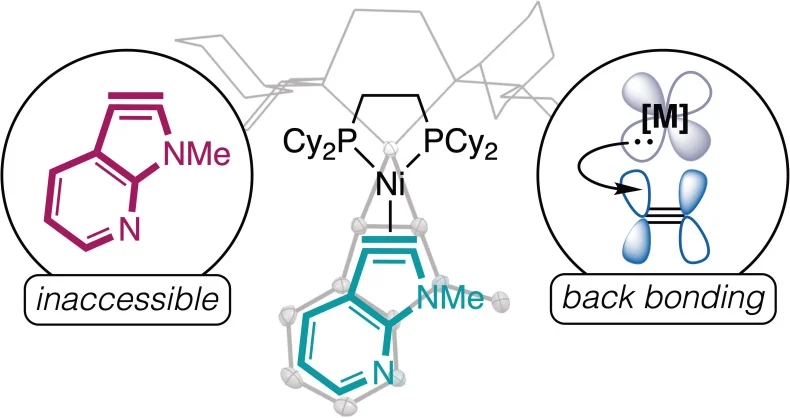博文
破解百年化学难题:研究人员揭示了改变游戏规则的化合物
 精选
精选
||
破解百年化学难题:研究人员揭示了改变游戏规则的化合物
诸平
据美国明尼苏达大学(University Of Minnesota, Minneapolis, MN, USA)2024年5月8日提供的消息,破解百年化学难题:研究人员揭示了改变游戏规则的化合物(Century-Old Chemistry Puzzle Solved: Researchers Unveils Game-Changing Compound)。
利用这些分子可以显著影响农业、制药和电子行业。明尼苏达大学双城科学与工程学院(University of Minnesota Twin Cities College of Science and Engineering)的化学家们成功地合成了一种高活性的化合物,科学家们已经躲避了120多年。这一突破可能为创新药物治疗、更安全的农产品和增强型电子产品的发展铺平道路。相关研究结果于2024年4月25日已经在《科学》(Science)杂志网站发表——Jenna N. Humke, Roman G. Belli, Erin E. Plasek, Sallu S. Kargbo, Annabel Q. Ansel, Courtney C. Roberts. Nickel binding enables isolation and reactivity of previously inaccessible 7-aza-2,3-indolynes. Science, 2024, 384(6694): 408-414. DOI: 10.1126/science.adi1606. Published Date : 25 April 2024. https://www.science.org/doi/10.1126/science.adi1606
几十年来,研究人员一直在研究一种叫做N-杂环化合物(N-heteroarenes)的分子,它是一种环状化合物,含有一个或多个氮原子。具有N-杂环化合物核(N-heteroarene core)的生物活性分子被广泛用于许多医疗应用,救生药物,杀虫剂和除草剂,甚至电子产品。
该研究的资深作者、明尼苏达大学化学系助理教授、3M校友教授(3M Alumni Professorship)考特尼·罗伯茨(Courtney Roberts)说:“虽然一般人不会每天都想到杂环,但这些独特的含氮分子被广泛应用于人类生活的各个方面。”
化学合成的挑战(Challenges in Chemical Synthesis)
这些分子在许多行业都很受欢迎,但对化学家来说,制造它们却极具挑战性。以前的策略已经能够针对这些特定的分子,但科学家们还没能创造出一系列这样的分子。其中一个原因是这些分子具有极强的活性。它们是如此活跃,以至于化学家们使用计算模型来预测它们应该是不可能制造出来的。一个多世纪以来,这一直是制造这种化学物质的挑战,阻碍了找到制造这种化学物质的解决方案。
明尼苏达大学化学研究生、上述论文的第一作者詹娜·哈姆克(Jenna N. Humke)说:“我们所能做的就是用专门的设备进行这些化学反应,同时去除大气中常见的元素。幸运的是,我们明尼苏达大学有这样的工具。我们在一个封闭的手套箱中进行氮气实验,这为测试和移动样品创造了一个化学非活性的环境(chemically inactive environment)。”
这些实验是利用金属与有机分子之间的相互作用来完成的。这项研究需要有机化学家和无机化学家的合作。这在明尼苏达大学很常见。
考特尼·罗伯茨补充说:“我们能够解决这个长期存在的挑战,因为明尼苏达大学化学系的独特之处在于我们没有正式的分科部门。这使我们能够组建一个由化学各个领域的专家组成的团队,这是完成这个项目的重要组成部分。”
在上述论文中介绍了这种化合物之后,下一步将是使其广泛适用于多个领域的化学家,以简化创造过程。这可以帮助解决一些重要的问题,比如防止食物短缺和治疗疾病以拯救生命。
除了考特尼·罗伯茨和詹娜·哈姆克,明尼苏达大学的研究团队还包括博士后研究者罗曼·贝利(Roman G. Belli)、研究生艾琳·普拉塞克(Erin E. Plasek)、萨卢·卡尔博(Sallu S. Kargbo)和前博士后研究者安娜贝尔·安塞尔(Annabel Q. Ansel)。
这项工作主要由美国国立卫生研究院(National Institutes of Health)和美国国家科学基金会(National Science Foundation)资助。明尼苏达大学赞助了4个研究生研究奖学金,明尼苏达大学化学系提供了研究的启动资金。
上述介绍,仅供参考。欲了解更多信息,敬请注意浏览原文或者相关报道。
How tightly can a carbon-carbon triple bond be confined? With the right driving reactions, it has become straightforward to squeeze the motif into six-membered rings such as benzyne and then reap the benefit of the prompt reactivity promoted by the strain. However, five-membered rings have tended to be too tight a squeeze. Humke et al. now report that coordination by nickel can relieve the strain just enough to stabilize a triple bond in the pentagonal portion of azaindoles. These azaindolyne complexes were crystallographically characterized and reacted with both nucleophiles and electrophiles. —Jake S. Yeston
N-Heteroaromatics are key elements of pharmaceuticals, agrochemicals, and materials. N-Heteroarynes provide a scaffold to build these essential molecules but are underused because five-membered N-heteroarynes have been largely inaccessible on account of the strain of a triple bond in that small of a ring. On the basis of principles of metal-ligand interactions that are foundational to organometallic chemistry, in this work we report the stabilization of five-membered N-heteroarynes in the nickel coordination sphere. A series of 1,2-bis(dicyclohexylphosphino)ethane nickel 7-azaindol-2,3-yne complexes were synthesized and characterized crystallographically and spectroscopically. Ambiphilic reactivity of the nickel 7-azaindol-2,3-yne complexes was observed with multiple nucleophilic, electrophilic, and enophilic coupling partners.
https://blog.sciencenet.cn/blog-212210-1433671.html
上一篇:揭示维生素D抗癌的潜力
下一篇:量子纠缠被纠缠证人揭露

